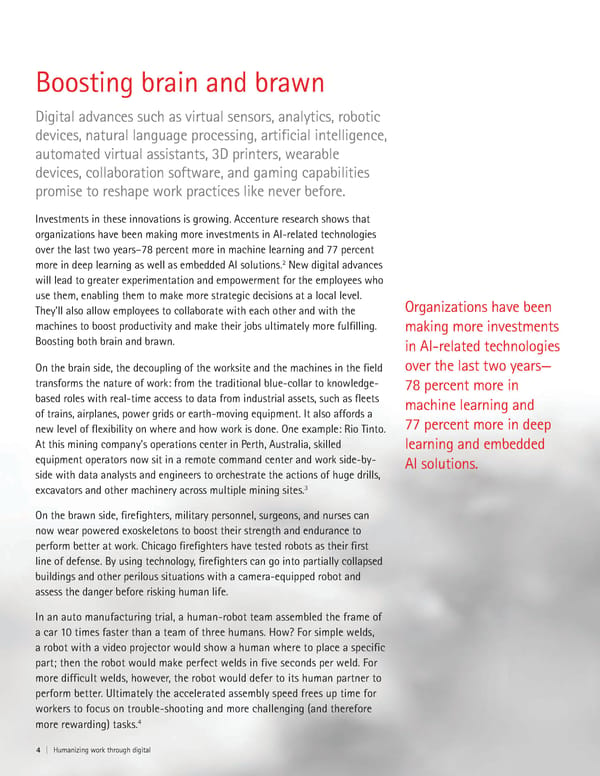Boosting brain and brawn Digital advances such as virtual sensors, analytics, robotic devices, natural language processing, artificial intelligence, automated virtual assistants, 3D printers, wearable devices, collaboration software, and gaming capabilities promise to reshape work practices like never before. Investments in these innovations is growing. Accenture research shows that organizations have been making more investments in AI-related technologies over the last two years–78 percent more in machine learning and 77 percent 2 more in deep learning as well as embedded AI solutions. New digital advances will lead to greater experimentation and empowerment for the employees who use them, enabling them to make more strategic decisions at a local level. Organizations have been They’ll also allow employees to collaborate with each other and with the machines to boost productivity and make their jobs ultimately more fulfilling. making more investments Boosting both brain and brawn. in AI-related technologies On the brain side, the decoupling of the worksite and the machines in the field over the last two years— transforms the nature of work: from the traditional blue-collar to knowledge- 78 percent more in based roles with real-time access to data from industrial assets, such as fleets machine learning and of trains, airplanes, power grids or earth-moving equipment. It also affords a 77 percent more in deep new level of flexibility on where and how work is done. One example: Rio Tinto. At this mining company’s operations center in Perth, Australia, skilled learning and embedded equipment operators now sit in a remote command center and work side-by- AI solutions. side with data analysts and engineers to orchestrate the actions of huge drills, 3 excavators and other machinery across multiple mining sites. On the brawn side, firefighters, military personnel, surgeons, and nurses can now wear powered exoskeletons to boost their strength and endurance to perform better at work. Chicago firefighters have tested robots as their first line of defense. By using technology, firefighters can go into partially collapsed buildings and other perilous situations with a camera-equipped robot and assess the danger before risking human life. In an auto manufacturing trial, a human-robot team assembled the frame of a car 10 times faster than a team of three humans. How? For simple welds, a robot with a video projector would show a human where to place a specific part; then the robot would make perfect welds in five seconds per weld. For more difficult welds, however, the robot would defer to its human partner to perform better. Ultimately the accelerated assembly speed frees up time for workers to focus on trouble-shooting and more challenging (and therefore 4 more rewarding) tasks. 4 | Humanizing work through digital
 Humanizing Work Through Digital Page 3 Page 5
Humanizing Work Through Digital Page 3 Page 5